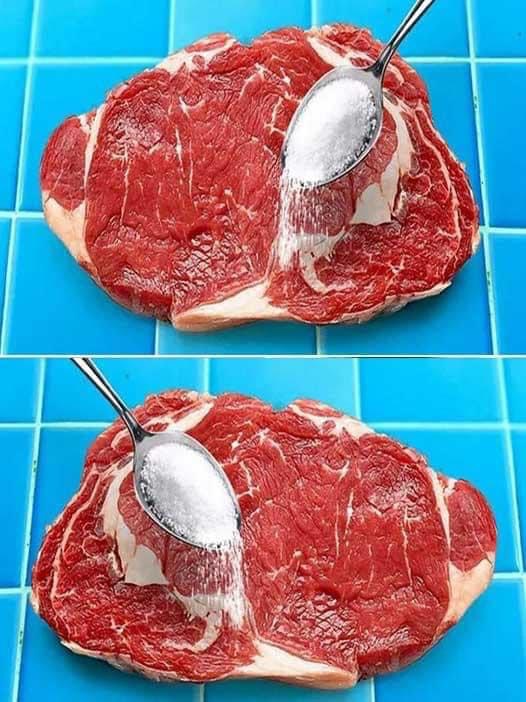The Chef’s Secret for Exceptionally Tender Meat: The Ultimate Guide

When it comes to cooking meat, achieving the perfect tenderness can sometimes feel like a daunting task. Fortunately, there’s a chef’s secret that can make all the difference: a special ingredient that transforms tough cuts into melt-in-your-mouth delights. Ready to elevate your meat dishes? Let’s dive into this game-changing tip.
The Secret Ingredient: Baking Soda
Why Baking Soda?
Baking soda, or sodium bicarbonate, is the unsung hero in the world of meat tenderizing. Its primary function is to alter the pH level of the meat, which breaks down proteins and makes the meat more tender. By making the meat less acidic, baking soda helps to retain moisture, resulting in a juicier, more succulent texture.
How to Use Baking Soda for Tender Meat
1. Choose Your Meat:
This method works well with various cuts of meat, including beef, chicken, and pork. For tougher cuts like flank steak or chicken breast, baking soda can be especially effective.
2. Prepare the Meat:
Start by slicing the meat into the desired pieces. If you’re cooking a larger cut, you can still use baking soda, but make sure to adjust the quantity accordingly.
3. Apply Baking Soda:
For every pound of meat, use approximately 1/4 to 1/2 teaspoon of baking soda. Sprinkle it evenly over the meat and gently rub it in. Be sure to coat all sides thoroughly.
4. Let it Rest:
Allow the meat to rest with the baking soda on it for about 15-30 minutes. This gives the baking soda time to work its magic. For best results, you can also refrigerate the meat during this time.
5. Rinse and Dry:
After the resting period, rinse the meat thoroughly under cold water to remove excess baking soda. Pat it dry with paper towels before cooking. This step is crucial to avoid any residual baking soda flavor in your dish.
6. Cook as Desired:
Now your meat is ready to be cooked. Use your preferred method, whether grilling, roasting, or pan-searing. The result will be exceptionally tender meat that’s sure to impress.
Benefits of Using Baking Soda
- Enhanced Tenderness: By breaking down proteins, baking soda ensures a softer texture.
- Juicier Meat: Baking soda helps retain moisture, preventing the meat from drying out.
- Versatility: Suitable for a variety of meats and cooking methods.
Additional Tips
- Don’t Overdo It: Using too much baking soda or leaving it on for too long can result in an unpleasant taste or a mushy texture. Stick to the recommended amount and time.
- Experiment: Different meats may require slight adjustments. Try varying the amount of baking soda to see what works best for your favorite cuts.
Are you interested in staying updated with us? Say yes, and we’ll keep you in the loop with more culinary tips and tricks!
The History of Baking Soda in Cooking
Origins of Baking Soda:
Baking soda, also known as sodium bicarbonate, has a fascinating history that dates back to ancient times. The substance was first discovered in ancient Egypt, where natural deposits of sodium carbonate were used in the mummification process and as a cleaning agent. However, the modern form of baking soda, as we know it today, became prominent in the 19th century.
Early Uses:
In the early 1800s, scientists began to understand the chemical properties of sodium bicarbonate more thoroughly. It was originally used in baking as a leavening agent to make dough rise. Before the advent of baking powder, which is a combination of baking soda and an acid, baking soda was a key ingredient in many baked goods.
Commercial Production:
The industrial production of baking soda began in the mid-19th century. In 1846, two chemists, John Dwight and Austin Church, founded the first company to produce baking soda commercially. Their company, known as the Church & Dwight Company, began selling baking soda under the brand name “Arm & Hammer,” which is still widely recognized today.
Evolution in Culinary Use:
Over time, the versatility of baking soda became apparent. Beyond baking, it was found to be useful in various cooking applications, including tenderizing meat. This discovery was part of the broader trend of exploring the multifaceted uses of baking soda in the kitchen.
Scientific Insights:
The discovery that baking soda could tenderize meat was a result of increased scientific understanding of food chemistry. Researchers and chefs alike realized that altering the pH level of meat could affect its texture. Baking soda’s ability to neutralize acids and break down proteins made it an effective tool for improving the tenderness of tough cuts of meat.
Modern Applications:
Today, baking soda is a staple in kitchens around the world, appreciated for its multiple uses. Its role in tenderizing meat is a testament to its versatile nature. Alongside its culinary uses, baking soda continues to be utilized in cleaning, personal care, and even medicine.
Conclusion
Baking soda’s journey from ancient Egypt to modern kitchens is a story of scientific discovery and culinary innovation. Its role in tenderizing meat is just one example of how this humble substance has evolved and adapted to meet the needs of cooks and chefs throughout history. Whether you’re baking, cooking, or experimenting in the kitchen, baking soda remains an invaluable ingredient with a rich and intriguing past.
By incorporating this simple yet effective technique into your cooking routine, you’ll be able to consistently achieve tender, flavorful meat that will make every meal a hit. Enjoy your culinary journey!
I can’t wait to try this. I use baking soda for a lot of things. Thank you for sharing this. Have a blessed day.